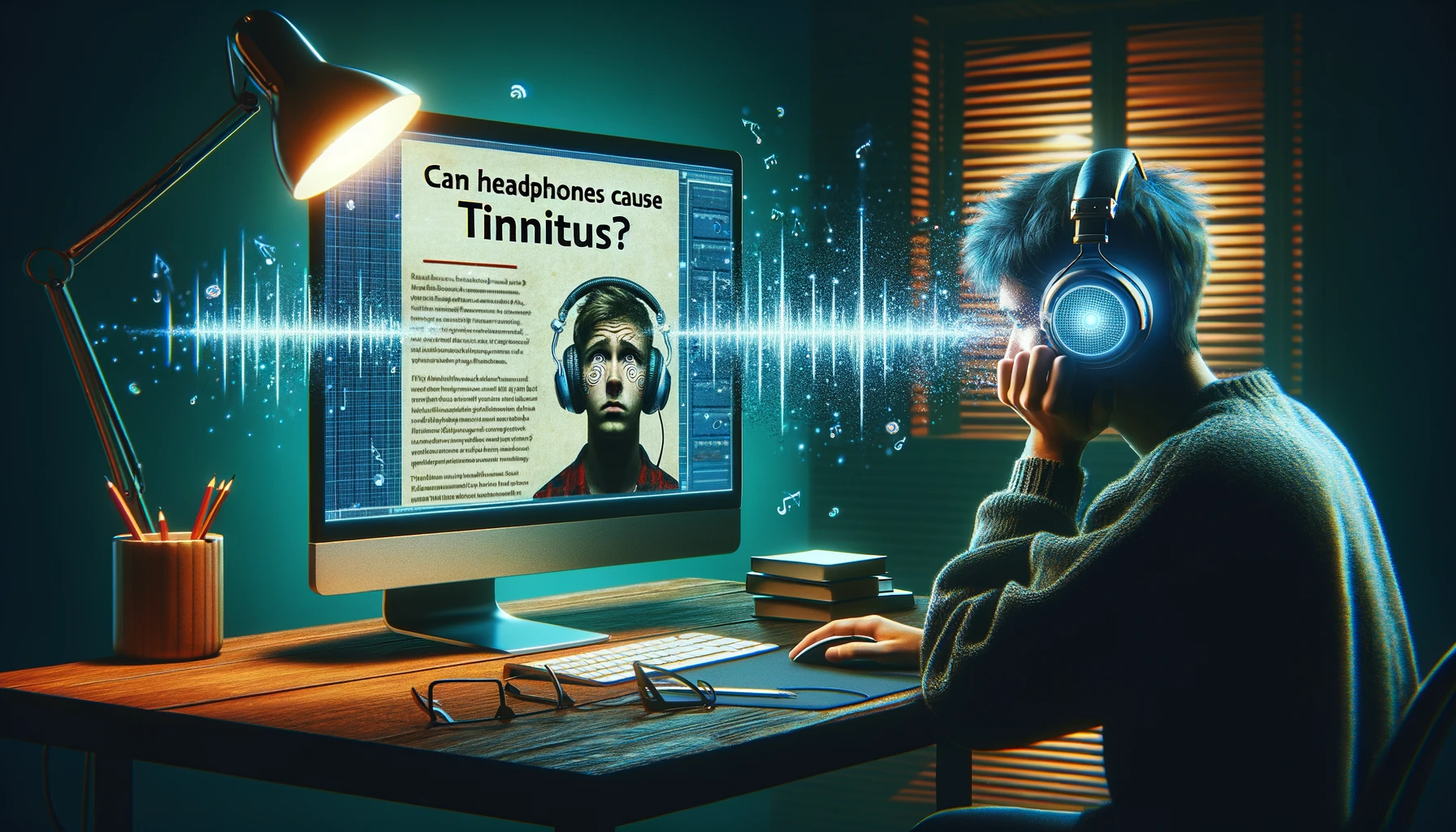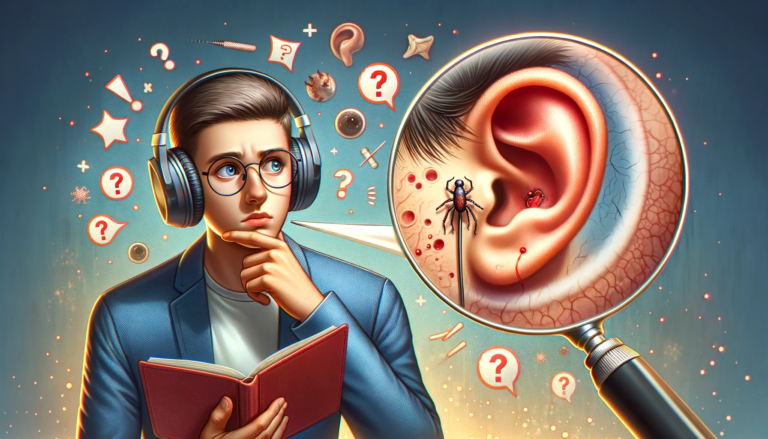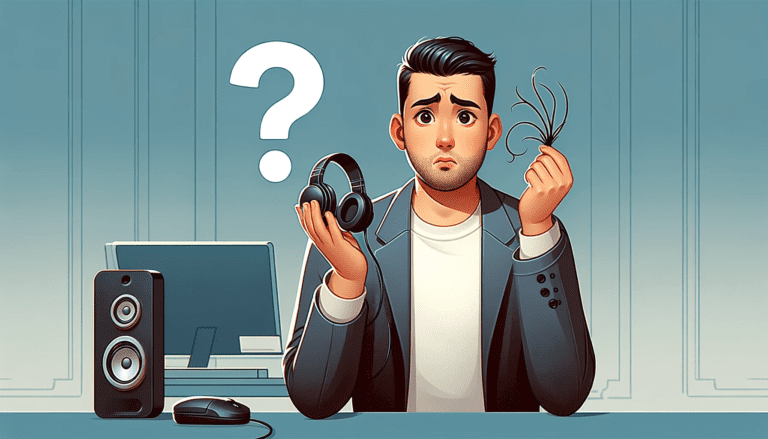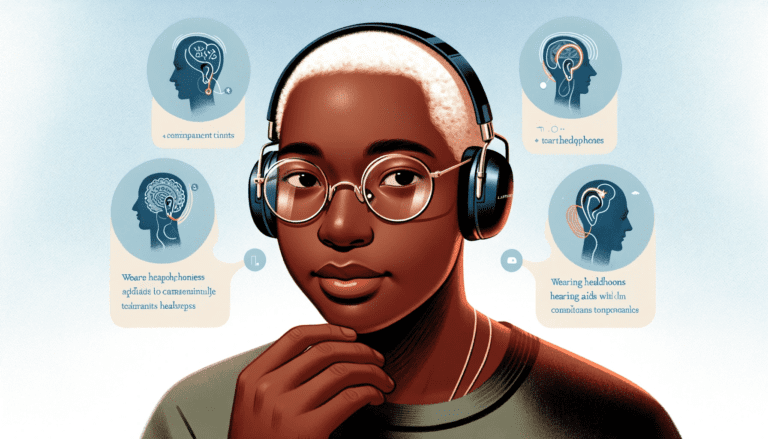Ever blissfully lost in the booming beats of your favorite jams, only to be rudely awakened by that dull, continuous ringing in your ears? You pause, wondering if it’s just the aftermath of those hard-hitting base notes or some sinister symptom of an underlying issue. “Can headphones cause tinnitus?” you ponder concernedly.
The answer, though complex, is a resounding yes. Headphones, particularly when used at exceptionally high volumes or for lengthy periods, can indeed cause tinnitus, that incessant ringing, buzzing, or hissing sound in your ears that seemingly originates from nowhere.
In this informative guide, we’ll venture into the depth of tinnitus, unravel its connection with headphones, and furnish you with tips to prevent or manage this potentially distressing condition. So, buckle up, headphone users—it’s time to tune into the reality of sound and silence!
Understanding Tinnitus: An Overview
Let’s dive right in, shall we? Tinnitus, derived from the Latin term for “ringing”, is characterized as the perception of noise or ringing in the ears. It’s not a condition in itself, but rather a symptom of an underlying condition that could be anything from age-related hearing loss or ear injury to a circulatory system disorder. However, not to worry, while it can be annoying, tinnitus isn’t a sign of something serious in most cases.
Now, you might be wondering, what does it sound like? Great question! People with tinnitus often observe a variety of sounds, including ringing, buzzing, roaring, clicking, hissing, or even humming. Notice anything peculiar here? Yes, that’s right, these are similar to sounds that you might hear when exposed to loud noises.
We’ve all been there: leaving a noisy concert, firing range, or even a boisterous party and hearing a ringing in our ears. That’s a temporary form of tinnitus, and it typically goes away shortly after our ears have had a chance to recover from the noise overload. This fleeting brush with tinnitus is an important reminder of how our ears respond to sound, giving us a hint into one of the most common causes of tinnitus – overexposure to loud noise.
But Tinnitus can also be chronic in nature. Chronic tinnitus lasts for more than six months. The constant noise in your ears can take a toll on your quality of life. From trouble sleeping to difficulty focusing on tasks, chronic tinnitus can seriously disrupt your day-to-day activities. But, the silver lining is that treatments are available to help manage and reduce the symptoms. Later in the article, we will cover when and how to seek help.
In fact, there might be an unexpected culprit behind some instances of tinnitus. You’ve probably guessed it from the title of this article – yes, we’re looking at you, headphones. Stick with us as we explore the connection between headphones and tinnitus in the following sections. You might be surprised by what you find out! You may read also Can Headphones Cause Ear Infection
What is the Connection Between Headphones and Tinnitus?
Let’s break it down. You might be asking yourself, how can simply wearing headphones possibly lead to tinnitus? It’s a valid question and to answer that, we need to delve into the inner workings of your ear and how sound is processed.
In simple terms, sound, in the form of sound waves, travels into your ear, hits your eardrum, vibrates the three tiny bones in your middle ear, and eventually reaches your inner ear or cochlea. Within the cochlea, there are thousands of tiny hair cells that convert these vibrations into electrical signals that your brain interprets as sound.
Unfortunately, prolonged exposure to loud noise can damage these delicate hair cells, leading to hearing problems including tinnitus. When you use headphones, especially at louder volumes, you’re delivering sound directly into your ear canal, bypassing many of the protective mechanisms your ear has against louder outside noise.
Is it just about volume, then?
Not entirely! The risk of developing tinnitus is influenced not just by how loud your music is, but also by how long you’re exposed to it. Listening to music at a lower volume over a longer period may cause just as much damage as listening to louder music for a shorter time.
Additionally, certain types of headphones may be more likely to cause damage leading to tinnitus. For example, earbuds—those tiny headphones that fit directly into your ear canal—are potentially more harmful than larger over-ear models, simply because they deliver sound more directly into your ear. But we’ll dig deeper into that in a later section.
Key takeaway: Using headphones, especially at loud volumes and for extended periods, can lead to damage in your inner ear, which may ultimately result in tinnitus.
The Causes of Tinnitus: Exploring the Role of Headphones
Our ears are delicate creatures. Deep within their labyrinthine structures, an array of fragile, hair-like cells dance in response to the vibrations of sound. When we expose these cells to loud noises, it can cause them damage which in turn facilitates a phenomenon we know as tinnitus.
So, where do headphones come into play? Settling snugly over our ears, headphones deliver music and other sounds directly into our auditory system. When cranked up to high volumes, they become a source of noise potent enough to potentially disturb our delicate auditory cells. This means that headphones can, indeed, be implicated as a contributing factor to developing this condition – but it’s a bit more complex than that.
The role of headphones
It’s not just that headphones can be loud – it’s also about how we use them. For instance, prolonged exposure to noise, even at a lower volume, can also contribute to the likelihood of developing tinnitus. Think about how often you see people wearing headphones – while working, exercising, commuting, or even as they navigate tasks at home. This consistent exposure to sound can accumulate over time, leading to strain and damage in our auditory system.
In addition to volume and duration, the type of sound we listen to also matters. Certain frequencies, especially those at the very high or low end of the scale, can be more strenuous for our auditory cells. If we’re repeatedly exposing our ears to these more challenging sounds through headphones, the risk of tinnitus can increase.
Finally, it’s important to remember that headphones themselves are not inherently ‘bad’. They are simply tools, and like any tool, their impact depends on how they’re employed. Used responsibly, headphones can provide a powerful and personal experience with sound. Used indiscriminately or without proper precautions, they can certainly contribute to conditions like tinnitus.
In essence, headphones could be described as being both a conduit and a potential catalyst when it comes to tinnitus.
The takeaway: it’s not necessarily the headphones themselves that cause tinnitus – it’s the irresponsible usage. Next, we’ll take a look at other habits that could potentially lead to tinnitus. You may read the guide on Do Headphones Cause Hair Loss
Impact of Listening Habits on Tinnitus Development
Our listening habits play an essential role in the potential development of tinnitus. In today’s digital world, it’s more common than ever to use headphones for prolonged periods, whether it’s for work, gaming, or entertainment. However, this increase in usage can come with risks, particularly when it pertains to our auditory health.
So how do our habitual patterns of headphone usage contribute towards tinnitus development? Let’s dive in and explore the correlation.
Volume and Duration: Two crucial factors that significantly impact the likelihood of developing tinnitus are volume and duration. Listening to audio at high volumes through headphones can cause acoustic over-exposure, leading to noise-induced hearing loss (NIHL), which is a common trigger for tinnitus. Furthermore, even at lower volumes, prolonged use of headphones can similarly result in NIHL, contributing to tinnitus onset.
Continuous Exposure: Continuous exposure to loud sounds without allowing periods of quiet can also influence auditory health. This continuous exposure can become a damaging force, gradually leading to tinnitus, by causing permanent changes in the inner ear. Remember, your ears need ‘breaks’ to recover, similar to how muscles need rests between workouts.
“Turning down the volume and taking regular breaks is essential for safe and responsible headphone usage.”
The “60/60” Rule: To better manage volume and duration, experts often recommend the “60/60” rule. It suggests listening to headphones at no more than 60% of the maximum volume for no more than 60 minutes at a time. After which, it is advisable to take a break, giving your ears the much-needed rest they deserve.
Sound Isolation: It’s also important to consider the role of sound isolation. With noise-cancelling headphones, we are more inclined to listen at lower volume levels because background noise is significantly minimized. Hence, this feature might indirectly reduce the risk of developing tinnitus.
Now that we have better insight into the ways our listening habits impact tinnitus development, it’s evident that modifying these patterns could make a real difference. Promoting responsible headphone use will not only protect our auditory health but also decrease the risk of developing conditions such as tinnitus.
Scientific Evidence: Can Headphones Lead to Tinnitus?
Often, it’s evidence-based research that can shed the definitive light on frequently asked questions. So, what does science tell us about the relationship between headphone usage and tinnitus? Let’s delve into that.
Various research studies have indeed linked prolonged and loud headphone usage to tinnitus. According to a study published in the Ear and Hearing Journal, listening to loud music through headphones can potentially lead to the development of tinnitus. The researchers noted that overexposure to loud sounds can cause irreversible damage to the inner ear’s hair cells, leading to tinnitus and even hearing loss.
Audiologists’ Perspective:
Professional opinion from audiologists often aligns with these scientific findings. Audiologists frequently observe a correlation between increased headphone usage, especially at high volumes, and a rise in tinnitus cases. Their experiences indicate that many patients diagnosed with tinnitus initially report symptoms after extensively using headphones, suggesting substantial anecdotal evidence to support the scientific research results.
However, it’s crucial to remain cognizant that research in this field is ongoing, and it’s not solely headphones that contribute to tinnitus. Multiple factors such as age, genetics, certain medications, and exposure to loud noise in general can all play a role.
“While headphones can contribute to the development of tinnitus, they are not the sole cause. Different factors work together to contribute to tinnitus. Mindful and responsible usage of headphones can significantly mitigate the risk.” – World Health Organization
While there is compelling evidence to suggest a link between headphone usage and tinnitus, the relationship is not an assured cause-and-effect scenario. But what does this mean for you as a listener? Let’s discuss that further in the section on preventive measures and responsible headphone usage. Stay tuned!
Preventive Measures: Reducing the Risk of Tinnitus
Just as the old saying goes, prevention is better than cure. Now that we understand the link between headphones and the risk of developing tinnitus, let’s discuss some preventive strategies to keep this problematic condition at bay.
First and foremost, it’s all about how you use your headphones. Volume and duration are key factors here. Keeping the volume at a moderate level, preferably below 60% of the maximum volume, will significantly reduce your risk of inducing tinnitus. Similarly, giving your ears a break occasionally instead of continuous exposure to sound proves beneficial. Consider the 60-60 rule: Listen to your headphones at no more than 60% volume for no more than 60 minutes at a time.
- Use noise-canceling headphones when in noisy environments. They help in reducing the need to increase volume excessively to mask the ambient noise.
- Regularly clean your earbuds to prevent buildup or blockages which could lead to tinnitus.
- Limit alcohol and caffeine intake, as excessive consumption could exacerbate tinnitus symptoms.
Another essential preventive measure is regular hearing checks. If you’re a frequent headphone user, consider getting your hearing checked at least once a year. Early detection of hearing loss or tinnitus will allow you to take the necessary steps to prevent further damage.
Remember, your hearing is precious. It’s necessary to take preventive measures now to protect it for life.
Finding the right balance between headphone use and hearing safety is crucial. Responsible usage of headphones combined with proactive care strategies go a long way in preventing tinnitus and securing your auditory health. You may check also Do Noise-Canceling Headphones Protect Hearing
Headphone Safety: Tips for Responsible Usage
Welcome to the discussion about headphone safety. As we navigate this journey, let’s take a moment to focus on the significance of this topic. Responsible headphone use can not just prevent tinnitus, but it can also help maintain your overall hearing health. Now that you understand the potential risks related to headphones, it’s time to lessen those risks. Here are some tips to get you started.
- Control the volume: Avoid damaging your eardrums by sticking to the 60-60 rule. This means listening to music or other audio at 60% of the maximum volume for no more than 60 minutes a day. This balance allows your ears time to rest and helps prevent damage from excessive noise.
- Take regular breaks: Give your ears a break! For every hour of continual headphone use, consider taking a break of at least five minutes. This can effectively reduce the risk of tinnitus and other hearing disorders.
- Choose noise-canceling headphones: High levels of external noise often push us to increase the volume on our devices. Noise-canceling headphones can help by reducing the amount of ambient noise, allowing you to listen at a lower volume.
- Get regular check-ups: Regular hearing assessments with a healthcare professional can help detect early signs of hearing loss or tinnitus. Keep on top of your hearing health by scheduling routine check-ups.
Remember, using headphones responsibly doesn’t mean you have to sacrifice the enjoyment of your favorite tunes or podcasts! These tips are designed to let you keep doing what you love while prioritizing the health of your ears. As they say, prevention is better than a cure, and that’s no different when it comes to tinnitus.
Types of Headphones and Their Potential Impact on Hearing Health
Headphones can be categorized into two primary types – over-ear and in-ear headphones. Both have their perks, being designed according to different use cases, aesthetics, and comfort factors. However, when it comes to hearing health, they present unique challenges.
Over-ear headphones, also known as circumaural headphones, are usually large and cover the whole ear. Because they create a seal around your ear, they naturally block out environmental noises. This noise isolation feature enables you to listen to audio at lower volumes, in turn, potentially reducing the risk of tinnitus.
That said, it is essential to note that reducing the volume does not necessarily lower the possibility of tinnitus. Listening to any sound, even at a safe volume, for extended periods can still lead to hearing damage over time. Even with over-ear headphones, you need to maintain the discipline of keeping listening sessions short and breaks frequently.
In-ear headphones, or earbuds, deliver sound directly into the ear canal. This proximity to the eardrums means that they inherently pose a higher risk to your hearing, especially with prolonged use. Earbuds often compete with ambient noise, tempting users to increase volume and, in turn, risk over-exposure to sound.
Regardless of the headphone type, the core risk factor for developing tinnitus remains the same – prolonged exposure to excessive sound. Here’s a comparative table:
| Types of Headphones | Risk factors |
|---|---|
| Over-ear headphones | Lower risk if used correctly, but the risk increases with prolonged exposure even at safe volumes. |
| In-ear headphones (earbuds) | Higher risk due to direct delivery of sound into the ear canal. The risk significantly increases with volume. |
In conclusion, the impact on hearing health is not exclusively about the type of headphones you use but more about your listening habits. Both types of headphones can potentially contribute to tinnitus if used irresponsibly. Therefore, it’s important to practice mindful listening, regardless of the kind of headphones you have.
Are There Any Safe Alternatives to Traditional Headphones?
As we learn more about the potential risks of prolonged headphone usage, one might wonder, are there any safer alternatives to traditional headphones? You’ll be pleased to know that, yes, there are. Let’s delve into some of your potential options:
1. Bone-conduction headphones:
These innovative devices sit on your cheekbones, rather than directly in your ears. They work by emitting sound waves that vibrate the bones in your skull, sending these vibrations directly to the cochlea. As a result, they bypass the eardrum entirely. This arrangement could lower the risk of tinnitus, as the eardrum is spared from overexposure to loud noises.
2. Speakers:
A more traditional alternative to headphones is the usage of speakers. When listening levels are kept at a reasonable level and the listener is situated a suitable distance away, speakers may pose much less risk of inducing tinnitus.
3. Open-air headphones:
Open-air, or open-back, headphones are designed to allow sound to escape into the room, rather than trapping it directly against your eardrum. This design can reduce the amount of sound pressure on your eardrum significantly, potentially mitigating the risk of tinnitus.
Keep in mind, however, that while these alternatives may be safer, they’re not entirely risk-free. Just like traditional headphones, improper or excessive usage can still pose a threat to your hearing health. Always remember to listen responsibly, regardless of the device you’re using.
Remember: The key to protecting your ears doesn’t just lie in the type of equipment you use, but also in mindful and responsible usage. Whatever the device you choose to use, always prioritize moderation and give your ears the breaks they deserve. You may read also Can Bone Conduction Headphones Cause Hearing Loss
Prevention is Better Than Cure: Tips to Avoid Tinnitus
It’s true that prevention is better than cure. Now, you might ask: “How can I keep enjoying my music while still taking care of my ears?” Don’t worry, we’ve got you covered. It’s time to share some useful tips to help you avoid tinnitus when using headphones:
- Keep the volume at a safe level: Be aware of the volume you’re listening at. Always try to stick to the 60/60 rule: Listen at no more than 60% of the maximum volume for no more than 60 minutes a day. Remember, damaging noise is more about how loud and how long you listen.
- Invest in noise-canceling headphones: These can help in reducing background noise, allowing you to listen at lower volumes. Lesser volume equals a lesser chance of hearing loss, which means a lesser chance of developing tinnitus.
- Take regular breaks: It is crucial to give your ears a rest. Take a 5 to 10-minute break every hour – it can make a significant difference in maintaining your hearing health.
- Don’t sleep with your headphones on: It might seem harmless, but listening to music while sleeping can lead to accidents where the volume gets turned up without you realizing it.
- Get regular check-ups: Regular hearing checks can help catch any early signs of damage. Early detection of potential problems is always beneficial.
In addition to these practical tips, it’s important to listen to your body. If you start experiencing any signs of tinnitus such as ringing, buzzing, whistling, or hissing in your ears, stop using headphones immediately and consult a healthcare professional.
Remember, your hearing health needs your attention and care. So be smart about your headphone use and listen responsibly! You may check also Can You Wear Headphones with Hearing Aids
Conclusion
In conclusion, it’s evident that, while not the sole cause, excessive headphone use can significantly contribute to the development of tinnitus. The act of immersing oneself in music or sound at high volumes, especially over prolonged periods, can inevitably lead to harm to your hearing health, manifesting in conditions such as tinnitus. However, it’s crucial to note that responsible and moderated usage, coupled with the right types of headphones, could potentially mitigate the risk. In the end, it is our individual choices and actions that hold the key to preserving our hearing health.







